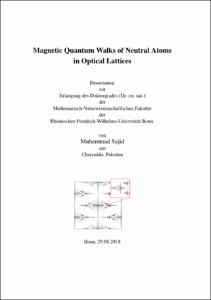Sajid, Muhammad: Magnetic Quantum Walks of Neutral Atoms in Optical Lattices. - Bonn, 2018. - Dissertation, Rheinische Friedrich-Wilhelms-Universität Bonn.
Online-Ausgabe in bonndoc: https://nbn-resolving.org/urn:nbn:de:hbz:5n-51894
Online-Ausgabe in bonndoc: https://nbn-resolving.org/urn:nbn:de:hbz:5n-51894
@phdthesis{handle:20.500.11811/7632,
urn: https://nbn-resolving.org/urn:nbn:de:hbz:5n-51894,
author = {{Muhammad Sajid}},
title = {Magnetic Quantum Walks of Neutral Atoms in Optical Lattices},
school = {Rheinische Friedrich-Wilhelms-Universität Bonn},
year = 2018,
month = sep,
note = {This thesis focuses on the simulation of the physics of a charged particle under an external magnetic field by using discrete-time quantum walks of a spin-1/2 particle in a two-dimensional lattice. By Floquet-engineering the quantum-walk protocol, an Aharonov–Bohm geometric phase is imprinted onto closed-loop paths in the lattice, thus realizing an abelian gauge field—the analog of a magnetic flux threading a two-dimensional electron gas. I show that in the strong-field regime, i.e. when the flux per plaquette of the lattice is a sizable fraction of the flux quantum, magnetic quantum walks give rise to nearly flat energy bands. I demonstrate that the system behaves like a Chern insulator by computing the Chern numbers of the energy bands and studying the excitation of the midgap topologically protected edge modes. These modes are extended all along the boundaries of the magnetic domains and remain robust against perturbations that respect the gap closing conditions. Furthermore, I discuss a possible experimental implementation of this scheme using neutral atoms trapped in two dimensional spin-dependent optical lattices. The proposed scheme has a number of unique features, e.g. it allows one to generate arbitrary magnetic-field landscapes, including those with sharp boundaries along which topologically protected edge states can be localized and probed. Additionally, I introduce the scattering matrix approach in discrete-time quantum walks to probe the Hofstadter spectrum and compute its topological invariants. By opening up a discrete-time quantum walk system and connecting it to metallic leads, I demonstrate that the reflection/transmission probabilities of a particle from the scattering region give information on the energy spectrum and topological invariants of the system. Although the work presented here focuses on the physics of a single particle in a clean system, it sets the stage for studies of many-body topological states in the presence of interactions and disorder.},
url = {https://hdl.handle.net/20.500.11811/7632}
}
urn: https://nbn-resolving.org/urn:nbn:de:hbz:5n-51894,
author = {{Muhammad Sajid}},
title = {Magnetic Quantum Walks of Neutral Atoms in Optical Lattices},
school = {Rheinische Friedrich-Wilhelms-Universität Bonn},
year = 2018,
month = sep,
note = {This thesis focuses on the simulation of the physics of a charged particle under an external magnetic field by using discrete-time quantum walks of a spin-1/2 particle in a two-dimensional lattice. By Floquet-engineering the quantum-walk protocol, an Aharonov–Bohm geometric phase is imprinted onto closed-loop paths in the lattice, thus realizing an abelian gauge field—the analog of a magnetic flux threading a two-dimensional electron gas. I show that in the strong-field regime, i.e. when the flux per plaquette of the lattice is a sizable fraction of the flux quantum, magnetic quantum walks give rise to nearly flat energy bands. I demonstrate that the system behaves like a Chern insulator by computing the Chern numbers of the energy bands and studying the excitation of the midgap topologically protected edge modes. These modes are extended all along the boundaries of the magnetic domains and remain robust against perturbations that respect the gap closing conditions. Furthermore, I discuss a possible experimental implementation of this scheme using neutral atoms trapped in two dimensional spin-dependent optical lattices. The proposed scheme has a number of unique features, e.g. it allows one to generate arbitrary magnetic-field landscapes, including those with sharp boundaries along which topologically protected edge states can be localized and probed. Additionally, I introduce the scattering matrix approach in discrete-time quantum walks to probe the Hofstadter spectrum and compute its topological invariants. By opening up a discrete-time quantum walk system and connecting it to metallic leads, I demonstrate that the reflection/transmission probabilities of a particle from the scattering region give information on the energy spectrum and topological invariants of the system. Although the work presented here focuses on the physics of a single particle in a clean system, it sets the stage for studies of many-body topological states in the presence of interactions and disorder.},
url = {https://hdl.handle.net/20.500.11811/7632}
}






